Trekking the Manaslu Annapurna Circuit in Nepal…
Before being granted the Warawara Award in 2023, our idea of a challenging hike was a couple of nights in the Australian Snowy Mountains. We had both always dreamed of trekking the Himalayas but never expected to be able to do it anytime soon. It wasn’t until we were sat at RRC one day and we hear about a new grant, the Warawara Award, designed to push applicants outside their comfort zones and allow them to pursue adventures they otherwise wouldn’t – next thing we know we both start thinking “what if?”.
Initially the idea of trekking in Nepal was quite daunting – in the brainstorming process we remember saying things like “but we’ve never hiked for more than 3 nights” and “what if we react badly to the altitude”. After a lot of research, it started to feel feasible, and we decided that we wanted to give it a shot. We wanted to experience the rich culture that Nepal has to offer and the main feature of the trek that we wanted to include was crossing the high altitude of a pass. We landed on the Manaslu Circuit Trek, a less built-up circuit, with amazing views of Manaslu – the 8th highest mountain in the world sitting at 8,163m. Out of all the applicants, our trip wasn’t necessarily the most out there, or the most challenging – but it was something that was going to push us both physically and mentally more than we have been before.
Next thing we know, our dream adventure that we thought may happen “one day” had a date – October 2024!
Suddenly our weekend filled up with day hikes and our long weekends were spent doing multi-day hikes. We had two training goals: build our stamina and strengthen our leg muscles.

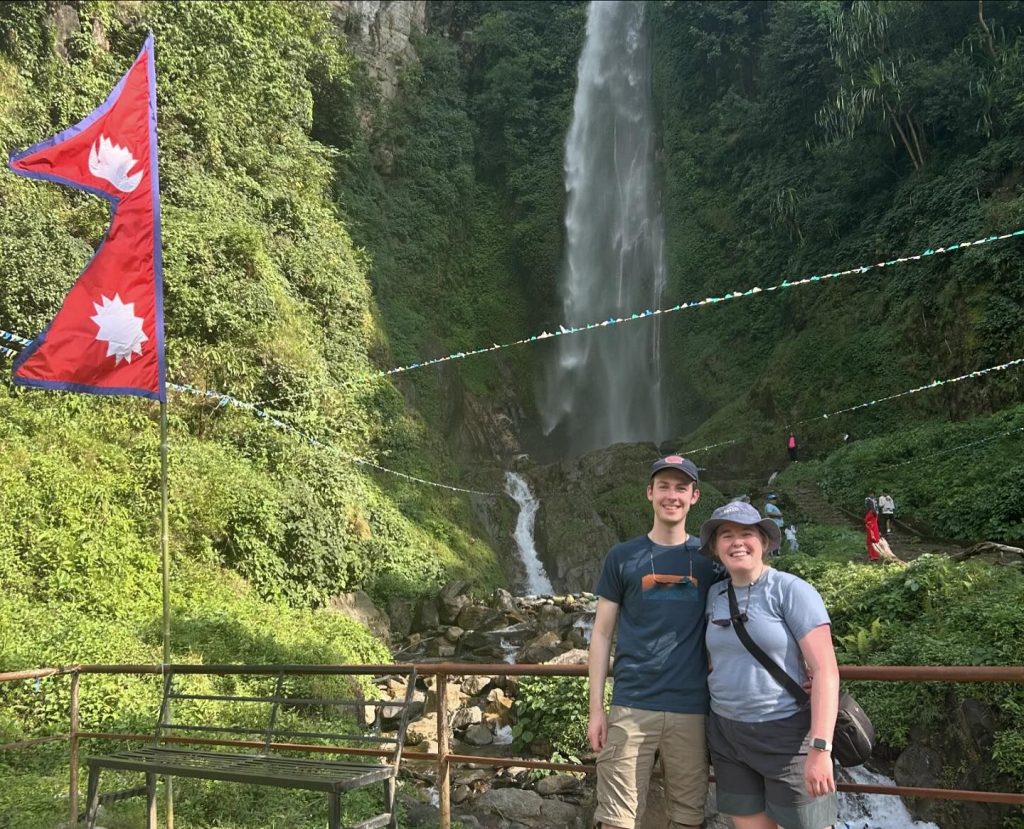
Fast forward to the week before we were due to depart, Nepal was hit with some of the worst rain and flooding since the 90’s. We were so worried that we would have to cancel our trip but our guide, Ish, assured us that it was still safe to come trekking, but he did warn us that we may have to pick a different trek. Unfortunately, the Manaslu Circuit was one of the most affected areas and had a lot of landslide damage, we concluded that it just wasn’t feasible to follow our original plans and that we would do the Annapurna Circuit instead. This circuit would give us a similar ‘off the beaten track’ feel, despite its popularity and let us see a similar region of Nepal.
Once we arrived in Nepal, we had a few days to ourselves to explore some of Kathmandu’s sites like Durbar Square and buy some of the super cheap trekking gear. When we landed we quickly learnt we had arrived in the beginning of festival season, meaning the streets were really busy with the locals out buying gifts and food for their families to take back to their home villages. Now fully kitted out, we were ready for our trek!
To get to the start of the trail we had a 4:30am start which allowed for a long drive to Besisahar. We hopped in the car our guide had arranged and strapped in for the ride (not literally because the seatbelts were broken as no one wears them in Nepal!). After about five hours in the car we pulled over just after a small town to pick up our guide, Ish, and porter, Denise, and next thing we know we got started on our first day of hiking.
We set off from the town of Besisahar and after a short stint of walking on the road we were greeted by stunning views of the local village farms, with rice being the primary crop in the area. These views made a perfect distraction from the killer hills and the surprisingly hot and humid climate that we’d face for the first few days of the hike. Soon we made it to our first overnight stop, Ngadi and got our first taste of the Nepali tea houses. These would be providing our accommodation and food for the length of the trek.
Leaving our overnight stop behind, we we’re excited to take on our first full day of hiking! The terrain was challenging with lots of steep climbs on narrow tracks, and the same hot sticky temperatures, so it wasn’t long before we had worked up a sweat. There were plenty of opportunities to rest along the track, whether it was a short stop at a lookout or a slightly longer break for some snacks and tea at the teahouses. We quickly learnt Ish’s catch phrase “slowly, slowly”… something he would say to encourage us to go our own pace and listen to when our bodies needed rest. A few steep staircases and gorgeous rice fields later, we arrived in Jagat, a slightly bigger town along the route and our stop for the night. For dinner we had our first taste of the local favourite, Dal Bhat, a dish consisting of steamed rice, pickled locally grown vegetables, curried potatoes, steamed vegetables and the best part, the bean/lentil stew.
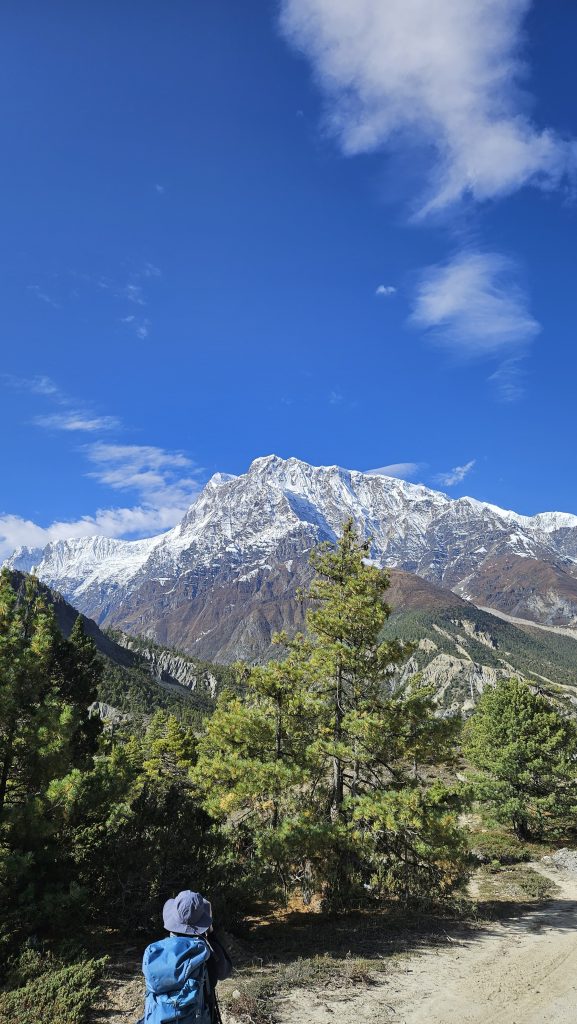
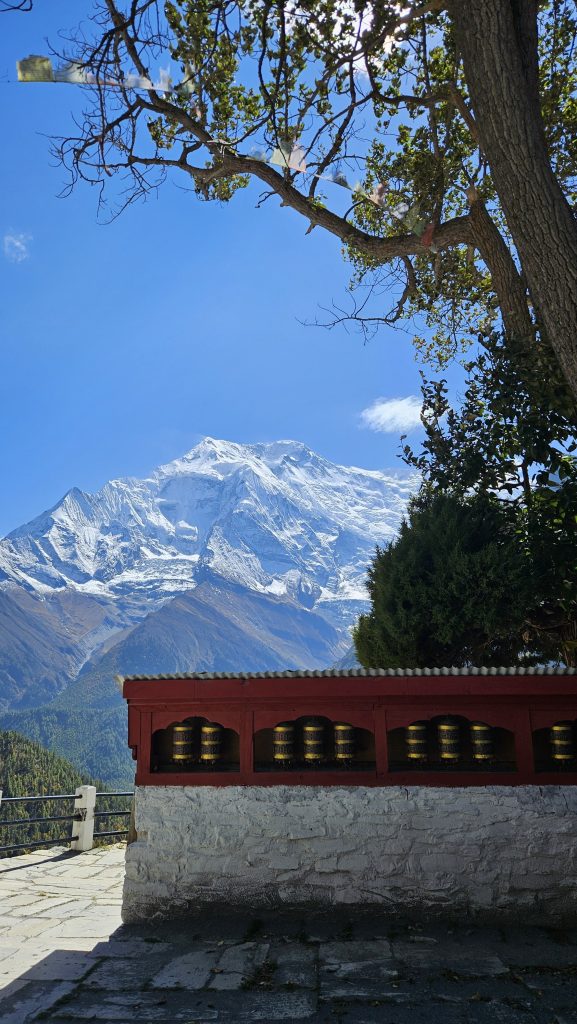
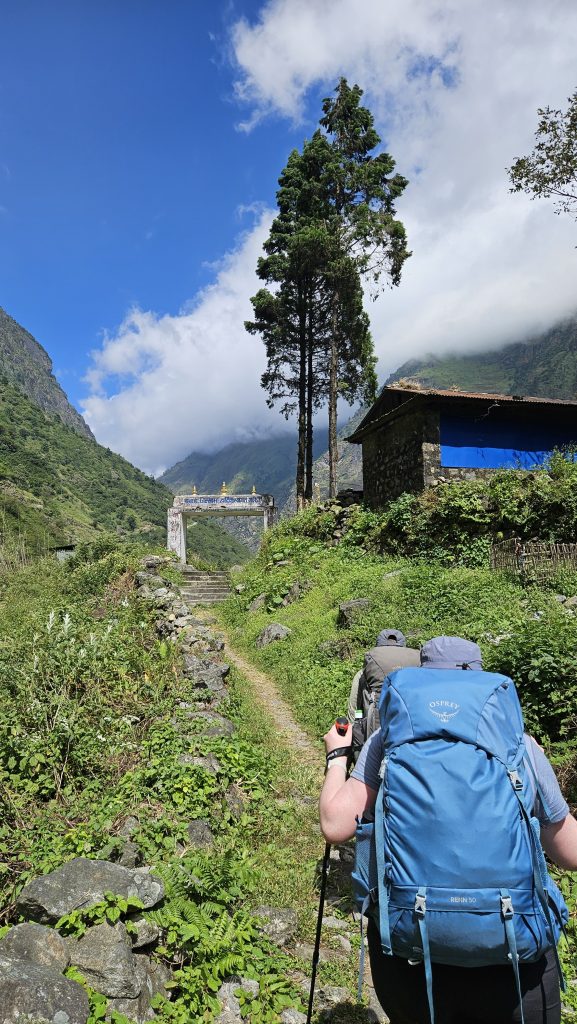
This next day was much the same as the previous two and we both felt like we were getting a hang of the routines and our bodies slowly getting used to the hills. Later in the day we exited the Lamjung Region of Nepal and entered the Manang District, where we would spend the majority of our trek. With this change of region also came new scenery, not only because we were climbing in altitude and leaving the rainforests behind for pine forests, but we were getting our first glimpses of the Himalayan mountains! We were also now in a mostly Buddhist region which brought with it beautiful Gompas and Stupas, and the prayer flags that are commonly associated with Nepalese trekking. We learnt that Gompas are a type of temple and usually where the Monks or Lamas will live, teach and practice and that Stupas are used as a sacred place for prayers, they always contain something valuable inside of it, whether it is gold or the remains of a monk or lama. Our first night in the Manang district was spectacular, we stayed in a town called Dharapani, which happened to be the one of the final days of the Manaslu Circuit, with great views of Lamjung Himal and to our surprise Manaslu!
Our next day was a taste of what was to come, we climbed from 1860m elevation up to 2670m which meant a lot of narrow staircases and a lot of breaks. These narrow staircases were only made skinnier by the locals ferrying goods between their villages via donkeys, something that became quite common the higher we got. We quickly learnt that the locals don’t consider anything smaller than 6,000m a mountain, and even though we were blown away by the views we kept being reminded by Ish and Denise that these were “only hills”. As the days were getting harder and the elevation higher the hikes were becoming shorter to allow for more rest, so once we had arrived in Chame (2,670m) we had time to play a few card games with Ish, Denise and some other guides and porters who were staying in the same tea house.
Well and truly settling into the routine of trekking now we set off towards Upper Pisang ready for another day. Along the way we stopped off at the local winery, Manang Valley Wineries, who make wine from apples. We decided that it was maybe best to avoid the wine and instead went for some fresh apples and apple juice to fuel us for the rest of the way to Upper Pisang. At an elevation of 3,300m it was starting to get pretty cold and windy at night, so we spent most of the evening huddled up in the dining room enjoying the warmth of the fire and Masala teas while we got to soak in the views of the Annapurna range for the first time.
Ish warned us that the next few days would tough with some monster climbs, but that we would have some of the best views of the Annapurna range over the next few days of the trip so it would all be worth it. Well, Ish, wasn’t wrong, with a killer set of switchbacks up towards Ngawal (3,657m) we had our work cut out for us ! It was by far the best day of the trek even despite the climb, we had beautifully clear, consistent views of the Annapurna ranges, with the main view being what we have decided was our favourite peak of the range, Annapurna II (7,937m). We saw plenty of bright and colourful Stupas and Gompas and decided to have a slightly longer lunch in Ghyaru (3,670m) to soak in the views and enjoyed some nice fresh Thukpa, a Tibetan noodle soup filled with fresh veggies. Our stop for the night Ngawal, happens to be one of the oldest towns in the region with plenty of traditional stone buildings and Stupas still standing. We were treated to a beautiful sunset over the mountain ranges that left us in awe.
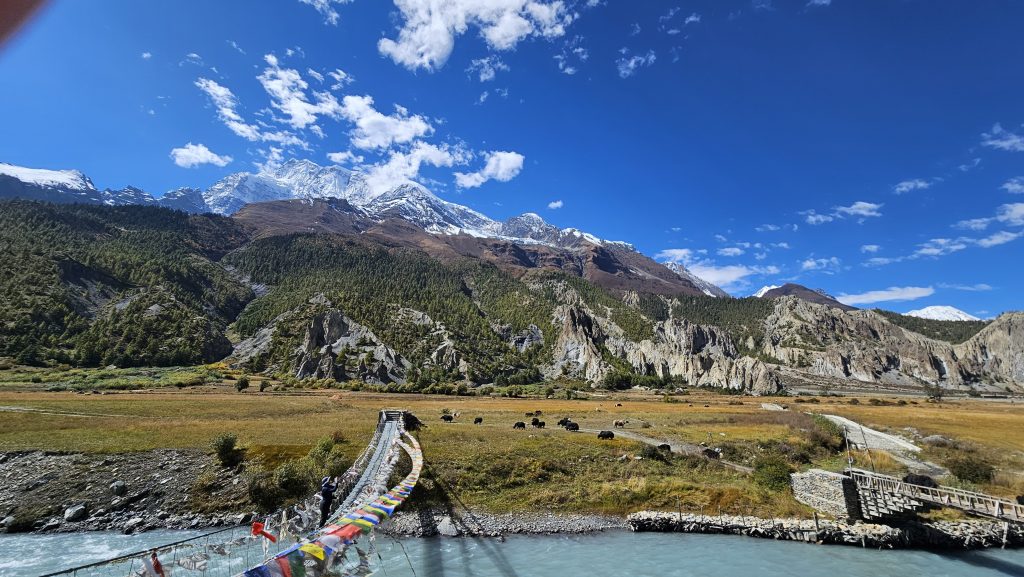
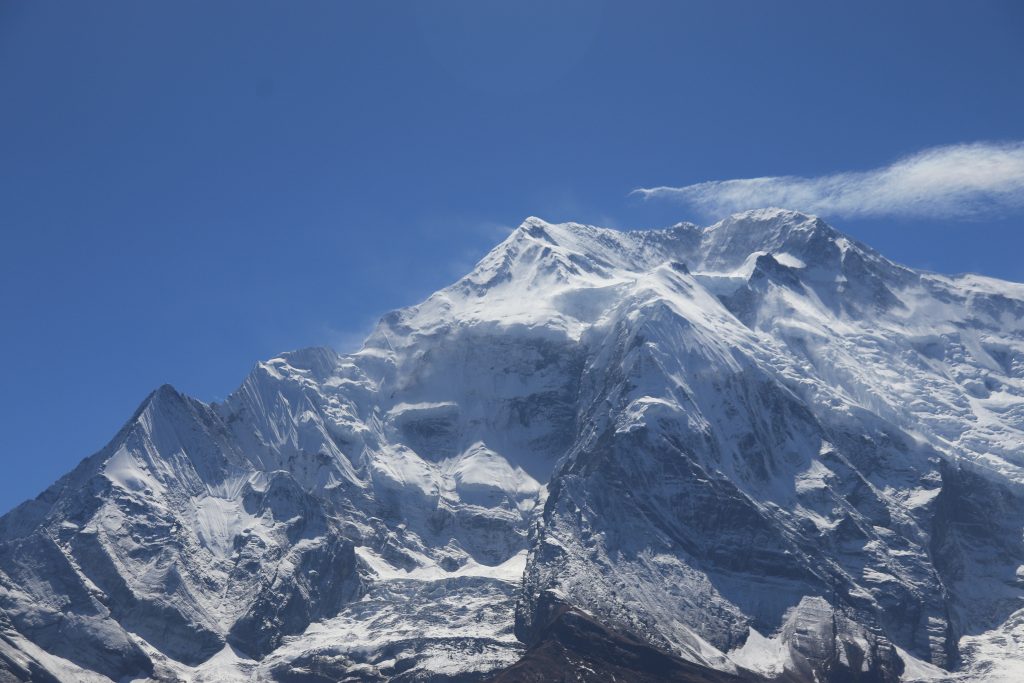
The hike to Manang the next morning was relatively easy, with most of the track being downhill – this was a welcome change from the rest of the hike! The downhill walk was a blessing, and so was the acclimatisation day which we knew would follow. Manang (3,540m) would become our home base for two nights, allowing us to climb high and sleep low for a few nights – one of the best practices to avoid altitude sickness. It is also the last town along the route that has road connection, between this and the large amount of hikers that spent their acclimatisation days here Manang was a slightly bigger town and the tea houses were fairly well equipped. We even found western-style bakeries with coffee machines, and when we spoke to the barista we learnt that she had previously lived in Sydney and trained as a barista and chef there before moving back to her home town.
On our acclimatisation day we did a lovely short hike up the side of the valley to a home of a Lama, built into the side of the mountain, who had passed away, which was now being looked after by his 90-year-old daughter, who’s training to become a Lama. While there we received a blessing from the lady, wishing us all a safe journey over the pass and that we return home safely, this was truly a special moment.
The following day was the start of the really difficult section of the Trek, although the distance we were travelling was the same or less kilometres, we were starting to ascend quickly into high altitudes, to the point where there was very little plant life around. This meant there was a severe lack of firewood, so when we arrived at our accommodation that night in Yak Kharka (4,018m) we found out that instead of burning wood, they used dried yak poo. Due to the tea houses from here on in being only accessible through either foot, horse or helicopter it also meant that the food was becoming a lot more basic. We still filled up and headed to bed to get our last full night’s sleep before we tackled the pass.
As the air noticeably thinned “slowly, slowly” had become our motto. While we had been listening to our bodies and resting when needed for the entirety of the hike, it was now critical to not push ourselves too hard because now once you’d lost your breath, you’d really struggle to catch it again. Aside from noticing the altitude, the path was becoming increasingly difficult to walk due to it being built by crushed rocks from landslides so the surface was very uneven. The last part of the track that day was a 360m long suspension bridge over the valley which led us to our last overnight stop of the trek before the pass, Thorang Phedi at 4,455m. This is where it got serious, we were thoroughly briefed on the pass and were encouraged to get to bed early because we likely wouldn’t sleep due to the altitude.

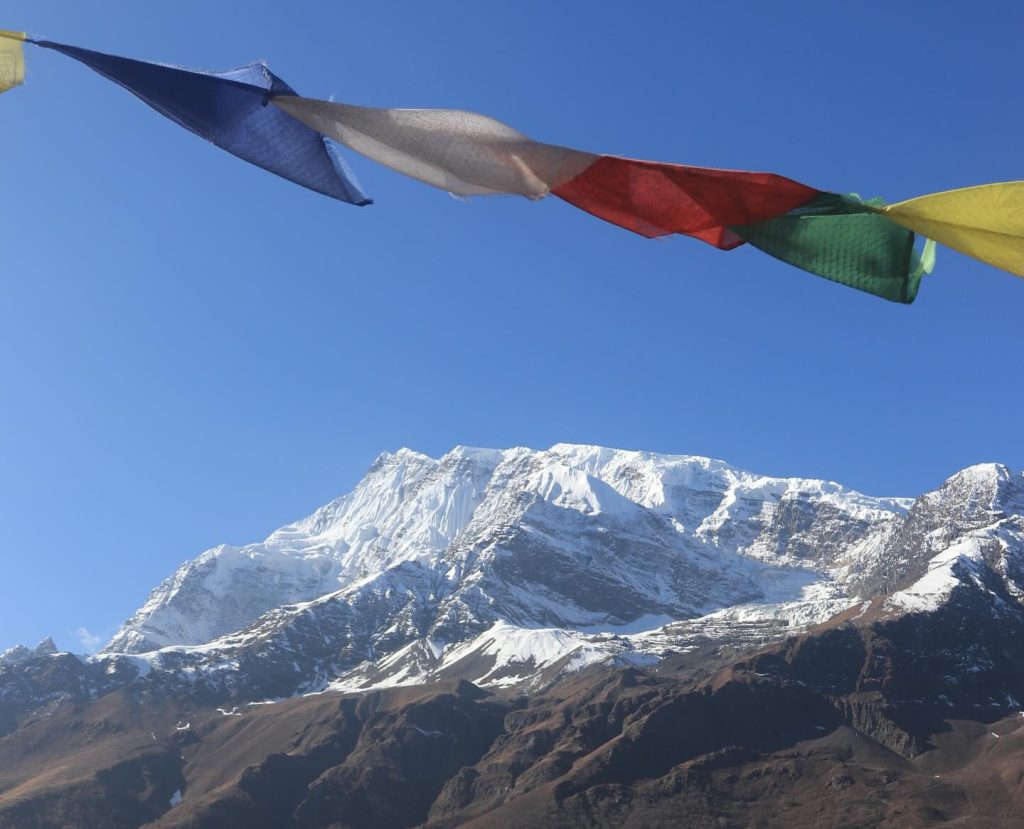
We didn’t get a great deal of sleep that night, but when we woke up at 3am the next morning we were filled with adrenaline and excitement to climb to the high pass, Thorang La Pass. We slowly made our way up the very steep hillside and had some fantastic views of the sunrise over the mountains, but we noticed we were starting to slow down due to the altitude. Shortly after reaching an altitude of 5,000m Ish suggested that Emily was starting to show signs of acute altitude sickness and highly recommended that the best option going forward was to hire a horse to get her to the pass. This would conserve her energy, prevent the sickness getting any worse and would be the quickest and safest way to drop down in altitude again, the only real solution to altitude sickness. So off she went on a pony and the rest of the party continued walking. After we caught up to Emily, who had steamed ahead on the horse we had a quick tea and took in the amazing sights of Thorang La Pass. At 5,416m the views were fantastic, with a full panorama of all the mountains and surrounding valleys. We didn’t spend too much time at the pass, not just because Emily was displaying symptoms but also because it’s not ideal for any of us to stay at that altitude long. After some quick photos with the sign we started our descent rapidly down towards Muktinath, which was in a new region of Nepal, the Mustang region, known as the Gateway to Tibet. With every step down off the pass we took, we felt stronger and faster as the air was becoming denser – Emily must have been desperate to get off the mountain, because she well and truly steamed ahead of us. We stopped for a late lunch In Jhong and looked back at what we had just achieved, it had been a long day so far and there was still a decent distance to cover but it all felt so easy compared to what we had just achieved. That night in Muktinath we spent the time over dinner sharing our favourite memories of the trek with the guides and ourselves and had one final game of cards before getting some much-needed sleep.
From here we returned to Pokhara via car and spent a few nights there enjoying the sights (all while Daniel suffered from a short stint of Dengue Fever). We both agreed that we much preferred the vibe of Pokhara over Kathmandu. We then flew back to Kathmandu for one final night and snuck in a visit to the Monkey Temple before returning back to Australia.
We are so grateful to have been given the opportunity to do this trek and are so proud of what we were both capable of both mentally and physically. Knowing we can achieve challenges like the Annapurna Circuit has opened our eyes to the limits we had created that were holding us back, and we are very excited to pursue other new adventures in the future.
Daniel Atkinson & Emily Marsden
Forest Rover Crew
